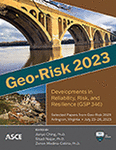Influences of Initial Conditions of Submarine Debris Flows on Their Run-Out Scenarios in the Shenhu Area, South China Sea
Publication: Geo-Risk 2023
ABSTRACT
Shenhu area is a potential hydrate exploitation zone. However, hydrate exploitation in this area may induce regional debris flows, which can destroy infrastructure. To quantitatively evaluate the areas vulnerable to disaster and the intensity of a potential disaster, the run-out behavior of debris flows should be systematically investigated. Previous studies have investigated the influences of the ambient fluid and the yield strength of the sliding material on the run-out scenarios of debris flows. This paper investigates the influence of the initial location of debris flow and analyzes the extreme disaster scenarios of concurrent multiple debris flows. Results show that a debris flow may damage an infrastructure only when they lie in the same watershed. In the extreme disaster scenarios of concurrent multiple debris flows, the maximum mass thickness and mass flow velocity are significantly greater than those of a single debris flow. The debris flow with a higher velocity can “absorb” the debris flow with a lower velocity to form a larger sliding body, which may amplify the damage to infrastructure.
Get full access to this article
View all available purchase options and get full access to this chapter.
REFERENCES
Chen, Y., Zhang, L., Liao, C., Jiang, M., and Peng, M. (2020). “A two-stage probabilistic approach for the risk assessment of submarine landslides induced by gas hydrate exploitation.” Appl. Ocean Res., 99, 102158.
Chen, Y., Zhang, L., Wei, X., Jiang, M., Liao, C., and Kou, H. (2021). “Simulation of runout behavior of submarine debris flows over regional natural terrain considering material softening.” Mar. Georesources Geotechnol., 1, 1–20.
De Blasio, F. V., Engvik, L., Harbitz, C. B., and Elverhøi, A. (2004). “Hydroplaning and submarine debris flows.” J. Geophys. Res. Ocean., 109, 1–16.
Guo, X., Stoesser, T., Nian, T., Jia, Y., and Liu, X. (2022). “Effect of pipeline surface roughness on peak impact forces caused by hydrodynamic submarine mudflow.” Ocean Eng., 243, 110184.
Kim, J., Løvholt, F., Issler, D., and Forsberg, C. F. (2019). “Landslide material control on tsunami genesis—the Storegga slide and tsunami (8,100 years BP).” J. Geophys. Res. Ocean., 124, 3607–3627.
Liu, F., Tan, L., Crosta, G., and Huang, Y. (2020). “Spatiotemporal destabilization modes of upper continental slopes undergoing hydrate dissociation.” Eng. Geol., 264, 105286.
Qian, X., and Das, H. S. (2019a). “Modeling Subsea Pipeline Movement Subjected to Submarine Debris-Flow Impact.” J. Pipeline Syst. Eng. Pract., 10, 04019016.
Qian, X., and Das, H. S. (2019b). “Modeling subaqueous and subaerial muddy debris flows.” J. Hydraul. Eng., 145, 04018083.
Qian, X., Xu, J., Das, H. S., Wang, D., and Bai, Y. (2020). “Improved modeling of subaerial and subaqueous muddy debris flows.” J. Hydraul. Eng., 146, 1–10.
Tan, L., Liu, F., Huang, Y., Crosta, G., Frattini, P., and Cen, X. (2021). “Production-induced instability of a gentle submarine slope: Potential impact of gas hydrate exploitation with the huff-puff method.” Eng. Geol., 289, 106174.
Wang, J., Xiao, L., and Ward, S. N. (2021). “Tsunami squares modeling of landslide tsunami generation considering the ‘Push Ahead’ effects in slide/water interactions: Theory, experimental validation, and sensitivity analyses.” Eng. Geol., 288, 106141.
Wang, X., Collett, T. S., Lee, M. W., Yang, S., Guo, Y., and Wu, S. (2014). “Geological controls on the occurrence of gas hydrate from core, downhole log, and seismic data in the Shenhu area, South China Sea.” Mar. Geol., 357, 272–292.
Wu, N., Zhang, H., Yang, S., Zhang, G., Liang, J., Lu, J., Su, X., Schultheiss, P., Holland, M., and Zhu, Y. (2011). “Gas hydrate system of Shenhu area, northern South China Sea: geochemical results.” J. Geol. Res., 20, 1–10.
Wu, S., Dong, D., Yang, S., Zhang, G., Wang, Z., Li, Q., Liang, J., Gong, Y., and Sun, Y. (2009). “Genetic model of the hydrate system in the fine grain sediments in the northern continental slope of South China Sea.” Chinese J. Geophys., 52, 1849–1857.
Xu, H., Yang, S., Zheng, X., Wang, M., and Wang, J. (2013). “Seismic identification of gas hydrate and its distribution in Shenhu area, South China Sea.” Chinese J. Geophys., 53, 574–582.
Ye, J., Qin, X., Xie, W., Lu, H., Ma, B., and Qiu, H. (2020). “The second natural gas hydrate production test in the South China Sea.” China Geol., 2, 197–209.
Zakeri, A., Høeg, K., and Nadim, F. (2009). “Submarine debris flow impact on pipelines - Part II: numerical analysis.” Coast. Eng., 56, 1–10.
Zhang, M., Lu, H., Guan, H., Liu, L., Wu, D., and Wu, N. (2018). “Methane seepage intensities traced by sulfur isotopes of pyrite and gypsum in sediment from the Shenhu area, South China Sea.” Acta Oceanol. Sin., 37, 20–27.
Zhang, W., et al. (2020). “Geological and geophysical features of and controls on occurrence and accumulation of gas hydrates in the first offshore gas-hydrate production test region in the Shenhu area, Northern South China Sea.” Mar. Pet. Geol., 114, 104191.
Information & Authors
Information
Published In
History
Published online: Jul 20, 2023
ASCE Technical Topics:
- Coasts, oceans, ports, and waterways engineering
- Debris
- Disaster risk management
- Disasters and hazards
- Education
- Engineering education
- Environmental engineering
- Flow (fluid dynamics)
- Fluid dynamics
- Fluid mechanics
- Fluid velocity
- Hydration
- Hydrologic engineering
- Infrastructure
- Laminating
- Materials engineering
- Materials processing
- Ocean engineering
- Pollutants
- Practice and Profession
- Solid wastes
- Solids flow
- Wastes
- Water and water resources
Authors
Metrics & Citations
Metrics
Citations
Download citation
If you have the appropriate software installed, you can download article citation data to the citation manager of your choice. Simply select your manager software from the list below and click Download.
